|
Surely one of the biggest turnouts for many
years at an archaeology event in Caithness. Local people had
spotted the opportunity to get information from people who have spent
the last few years studying Caithness archaeology. Nan Bethune
from Dunbeath Preservation Trust herself well versed in local history
and with a particular interest in the early periods when the Brochs and
Cairns were built organised the day. The walkers had the
opportunity to hear from Dr Andrew Baines, Dr Kenneth Brophy and Amelia
Pannett a PhD student from Cardiff University specialising in the
monuments of the first farmers in Caithness.
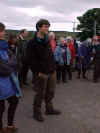
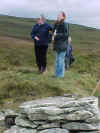
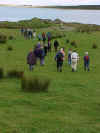
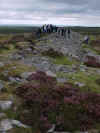 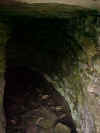
The crowd of about 70 had to be split into two groups and headed of
round the sites that are spread around the Yarrows loch and up Warehouse
hill. The area abounds with prehistory. With Long Cairns,
Round Cairns, Standing Rows (not visited on the day), hut circles, and
the magnificent Broch that stands beside Loch Yarrow.
For anyone who has walked around the area on their own and speculated
about the many cairns, standing stones, circles and the broch the day
provided a great opportunity to ask questions and hear what the current
thinking is.





The Yarrows Broch was excavated in the 1890's by Joseph
Anderson and several feet of debris was uncovered. The structure
would originally have been as high as a two storey house. It had
outbuildings and speculation was that the main family may have stayed in
the larger structure with lesser members in outer buildings surrounding
the main one. The building had two entrances which were almost
certainly constructed at its original conception. The bottom of
the broch was dry which is unusual as it is normally flooded by the
level of the reservoir which loch Yarrows now is. The loch is kept
at a higher level then it would have been when the broch was
constructed. This meant many people managed to get inside the
short passageway for the first time and look at the construction from
the inside.
The terrain would certainly have been very different and David Barclay,
countryside ranger later gave a description of what the area would have
looked like. The impact of man on the area over the millennia has
been significant. Once many species of tree and bush would have
grown and the peat landscape would not have existed in the area.
The climate was warmer and dryer lending itself to agriculture and
pastoral activities. Completely different to Orkney people in
Caithness would have felt they lived in a vast landscape with freedom to
roam the land looking for food or moving their animals. To see it
from the top of the hill described in this way it is easy to feel the
distances and see the mountains to the south and the sea nearby.
This was once a great place to live and would have provided timber for
warmth and shelter and well as plentiful game in the forest and fish in
the loch and sea.




From the Broch to a hut circle clearly visible if you follow the route
but helped on this occasion by the guidance of archaeologists. The
large house has not been excavated as most of the buildings in Caithness
have not been. It seems they must await another era before much
real work to discover the past in Caithness is carried out.
Substantial buildings were pointed out in the circles - with rooms 6 to
7 metres across. small arable areas almost certainly surrounded
the houses.
Then on up the hill to the round cairns - large structures and clearly
visible on top of the hill and on the lower slopes (not too difficult to
walk up). Reckoned to be Neolithic and Bronze Age these chambered
cairns may yet have many secrets to give to the future. On top of
one is a pile of stones which are the result of a whisky still of the
nineteenth century. Standing stones further down also belong to
the nineteenth century - possibly markers but not prehistoric as some
people may have thought when out walking.





In early times the game would have included Brown Bear,
Lynx, Beaver, Roe and Red Deer. 400 years ago much scrub was
cleared as it was feared wolves hid in it. Controlled burning over
the last couple of hundred years was to encourage grouse.
Long Cairns are very much in evidence and they are huge structures as
can be seen from the length in the photographs.
The area of Yarrows can easily be walked round and is near to many other
structures - fort, standing rows, cairns, cists and more in areas
nearby. Indeed the ordnance survey maps of the area mark many of
them and many are still being discovered especially when the heather
burns back.

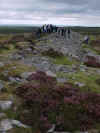

More
on Yarrows
|